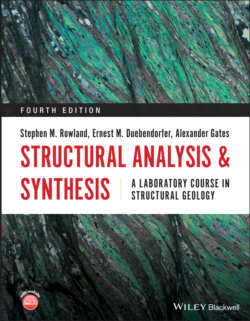Читать книгу Structural Analysis and Synthesis - Stephen M. Rowland - Страница 18
Structural Grain
ОглавлениеIn many areas, the structural geology controls the formation of the landscape. The alignment of ridges and valleys across an area can be controlled by the structural alignment of the bedrock. Such alignment is called structural grain. Structural grain is measured as a declination or bearing the same way as a strike or trend. A line can be drawn along or parallel to the general alignment of a ridge, expressed by the contours on a topographic map, as structural trend. The lines of structural grain are measured using a protractor, like strike or trend (Figure 1.6). Ridges are formed by more resistant units like quartzite, whereas valleys are more commonly underlain by less‐resistant rock such as shale. There can be several structural grains across a map depending upon the structural complexity of the bedrock in the area. By determining their orientations, the geology of an area may be more easily interpreted. Geologists use structural grain as a standard method to generalize the strike of units in geological interpretation.
Faults can also be recognized by topographic features. Faults are typically linear features on maps that can offset other topographic features such as ridges and valleys. They can also appear as profound breaks in topographic styles, juxtaposing hilly areas with flat areas. Active faults can offset rivers and other modern features. These fault lines are measured the same way as the structural grain with a protractor.
